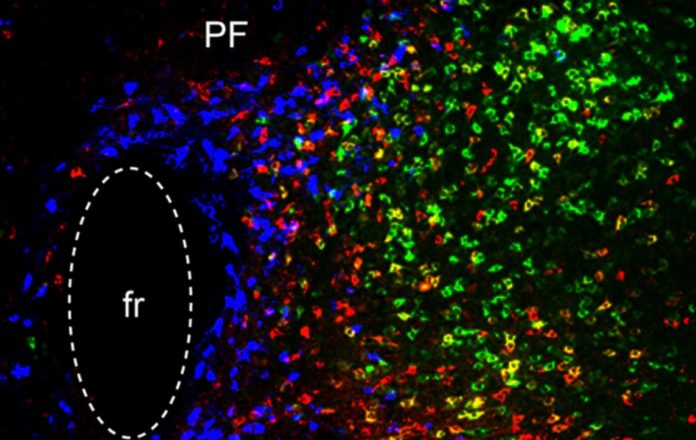Parkinson’s disease is primarily known for being a movement disorder. Tremors, loss of balance, and trouble initiating movement are common symptoms. Nonmotor symptoms of the condition, such as depression, are less well-known.
In this study, Neuroscientists at MIT looked at a small part of the thalamus and found three different circuits that affect both the motor and nonmotor symptoms of Parkinson’s.
Furthermore, scientists discovered that altering these circuits could reverse the symptoms of Parkinson’s disease in rats.
According to the researchers, the findings suggest that those circuits could be suitable targets for future medications that could help alleviate many of the symptoms of Parkinson’s disease.
We know the thalamus is crucial in Parkinson’s disease, but a key concern is how to put together a circuit that can explain many things. According to Guoping Feng, the James W. and Patricia T. Poitras Professor in Brain and Cognitive Sciences at MIT, “Understanding different symptoms at a circuit level can help guide us in the development of better therapeutics.”
Feng is the study’s senior author, and it was published in Nature today. The paper’s principal authors are Ying Zhang, a J. Douglas Tan Postdoctoral Fellow at the McGovern Institute, and Dheeraj Roy, an NIH K99 Awardee and a McGovern Fellow at the Broad Institute.
Circuit tracing
The thalamus is made up of various separate sections that have different functions. Many of these, such as the parafascicular (PF) thalamus, aid in movement regulation. Patients with Parkinson’s disease often have degeneration of these structures, which is likely to contribute to their motor symptoms.
The goal of this research was to see how the PF thalamus is linked to other brain regions in order to understand more about its activities. They discovered that neurons from the PF thalamus project to three distinct areas of the basal ganglia, a group of structures involved in motor regulation and other functions: the caudate putamen (CPu), the subthalamic nucleus (STN), and the nucleus accumbens (NAc).
“We started with showing these different circuits, and we demonstrated that they’re mostly nonoverlapping, which strongly suggests that they have distinct functions,” Roy adds.
Additional research identified those functions. The circuit that goes to the CPu seems to have something to do with movement in general and slows down movement. Mice spent more time moving around the cage when the researchers inhibited this circuit.
The circuit that extends into the STN, on the other hand, is critical for motor learning, or the ability to practice a new motor skill. The researchers discovered that this circuit is required for a test in which mice must learn to balance on a spinning rod.
Finally, unlike the others, the circuit connecting the PF thalamus to the NAc is not involved in motor activity, according to the researchers. It appears to be tied to motivation instead. Inhibiting this circuit causes healthy mice to exhibit depressive-like behaviors, and they will no longer seek a reward such as sugar water.
Druggable targets
After determining the functioning of these three circuits, the researchers sought to investigate how they could be altered in Parkinson’s disease. They did this by using a Parkinson’s disease mouse model in which dopamine-producing neurons in the midbrain are destroyed.
They discovered that the connection between the PF thalamus and the CPu was strengthened in this Parkinson’s model, resulting in a decrease in total movement. Furthermore, the connections between the PF thalamus and the STN were reduced, making the accelerating rod task more difficult for the mice to learn.
Finally, the researchers demonstrated that in the Parkinson’s model, connections from the PF thalamus to the NAc were disrupted, resulting in depression-like symptoms in mice, including loss of motivation.
Using chemogenetics or optogenetics, which let them control neuronal activity with a drug or light, the study discovered that they could change each of these three circuits and reverse each set of Parkinson’s symptoms. The researchers next started to investigate into “druggable” molecular targets, and discovered that cells in each of the three PF thalamus regions contain various types of cholinergic receptors, which are activated by the neurotransmitter acetylcholine. They were also able to reverse Parkinson’s symptoms by blocking or activating certain receptors, depending on the circuit.
“We found three distinct cholinergic receptors that can be expressed in these three different PF circuits, and if we use antagonists or agonists to modulate these three different PF populations, we can rescue movement, motor learning, and also depression-like behavior in PD mice,” Zhang adds.
L-dopa, a precursor to dopamine, is commonly used to treat Parkinson’s patients. While this medicine aids patients in regaining motor control, it has little effect on motor learning or nonmotor symptoms, and patients become resistant to it over time.
The circuits identified in this study could be used as targets for novel Parkinson’s treatments, according to the researchers. The researchers discovered that the same sorts of neurons present in mouse brain circuits are also prevalent in nonhuman monkey brain circuits, and they are currently employing RNA sequencing to locate genes that are expressed particularly in those cells.
“RNA-sequencing technology will allow us to do a much more detailed molecular analysis in a cell-type specific way,” Feng believes. “There may be better druggable targets in these cells, and once you know the specific cell types you want to modulate, you can identify all kinds of potential targets in them,” adds the researcher.
Image Credit: Getty
You were reading: A New Way To Fix Motor Dysfunction And Depression In Parkinson’s Patients – Study Finds
